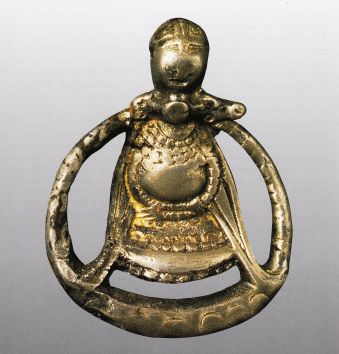Freyja
Text by Hallfridur J. Ragnheidardottir
I wrote this text in 2003.
It is reprinted here with permission from
ARAS, www.aras.org. Copyright 2010.

Period 800-1050 CE. Statens Historiska Museum, Stockholm.
Freyja´s arms, encircling her pregnant belly, echo the pendant´s circular rim, depicting the Serpent of Miðgarðr who lies in the ocean round the earth and bites his tail. As the snake renews itself by shedding its skin, so Freyja´s necklace, Brísinga men, symbolizes eternal, cyclic renewal. Part of a völva’s (prophetess’s) paraphernalia, men (pendant/necklace) is linked with seiðr, an ecstatic rite of divination and healing taught to gods and humans by Freyja.
In her search through foreign lands for her husband, Óðr, she is the driving force within, in the painful quest for love and fulfillment of creative potential. Deserted, she sheds tears of red gold. Of Óðr we know nothing but his name. It means poetry, or the intense emotions from which it springs. Their daughter is called Hnoss (treasure).
Her chariot is pulled by two cats. Also she is a symbol of ambivalence. On the one hand she embodies the healing power of the white solar cat, on the other the uncanny traits of the black cat, associated with the moon and the land of the dead. Equally at home in the light and dark spheres of human nature, she mediates between them. The cat is an independent animal. She beckons us to trust it. “As a symbol of consciousness, it is a psychic entity that knows the way.” (von Franz, ch.4)
The genesis of Brísinga men is an illumination of her role as mediatrice: She comes to a stone and finds that it is open. It turns out to be the smithy of four dwarfs who are forging a gold necklace. She is attracted to it, starts to negotiate, she wants it. Taken by her beauty, the dwarfs will let her have it only if she spends one night with each. She surrenders herself and emerges with the treasure.
Brísinga (gen.) means “flames of fire”, men is identical with the “moon-root” men, from which is also derived the “spirit-word” manas. (Neumann, 84/90) As in Norse mythology Sun is feminine and Moon masculine, Freyja’s adventure conjures up an image of the descending sun who abandons herself in the dissolving embrace of the moon in its dark phase, her red embers bleeding from under his coalblack disk, arranged in a flaming necklace. The healing power of the union is underscored by the number four, a universal symbol of wholeness.
The moon was magic, and so was the menstruating woman, whose period was commonly linked with the new moon, at which time it is conjunct with the sun. (Shuttle and Redgrove) The sacred menstrual flow of the goddess trickles through patriarchal myth in obscure poetic language. In the legends of later times we find her fountain of gold turned into a stagnant, but alluring, pit. In those noxious depths lies the key to a woman´s selfhood and creativity.
Freyja’s descent, desecrated by tradition as a manifestation of lasciviousness and greed, is an image of spiritual conception, heralding transformation and rebirth. It portrays the pull of the unconscious in its process of unfolding and woman as natural medium between its unborn truths and the conscious world.
Blöndal, Ásgeir. Íslensk orðsifjabók. Reykjavík, 1989.
Jónsson, Guðni, ed. “Sörla þáttr.” Fornaldar sögur Norðurlanda, I. Reykjavík, 1976.
Neumann, Erich. “On the Moon and Matriarchal Consciousness.” Tr. from German by Hildegard Nagel. Spring, 1954.
Nordal, Sigurður.Völuspá. Reykjavík, 1952.
Sturluson, Snorri. “Gylfaginning.” Úr Mímisbrunni. Ed. Sigurðsson, Gísli. Reykjavík, 1994.
Sturluson, Snorri. “Ynglinga saga”. Heimskringla, I. Ed. Aðalbjarnarson, Bjarni. Reykjavík, 1979.
Shuttle, Penelope and Redgrove, Peter. The Wise Wound: The Myths, Realities, and Meanings of Menstruation. New York, 1988.
Von Franz, Marie-Louise. The Cat: A Tale of Feminine Redemption. Toronto, 1999.
